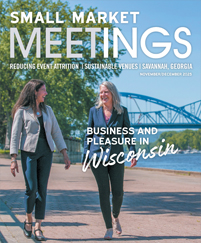A party without invitations is a recipe for disappointment.
So it goes for an event without well-planned registration. No matter how expertly designed an event, if registration is an afterthought, it will result in low attendance and dissatisfied attendees.
Registration is one of the most important components of event planning, and, with industry challenges such as smaller lead windows, limited budgets and late registration on the rise, it’s more critical than ever to get it right. So how are planners solving these challenges to streamline registration for events in 2025 and beyond?
Here is what three registration experts had to say.
Set Up Your Reg for Success
One of the worst mistakes event organizers can make is not having enough resources devoted to registration.
“From our side, we’re trying to establish that the registration itself needs to be handled as its own event, not just part of the event,” said Natasha Xavier, event registration specialist at Event Options EU. “It should have its own team that’s managing that section and not just the event organizer that’s trying to do everything at the same time.”
When hosting an event for thousands of attendees and exhibitors, there are bound to be questions that arise, from fixing software glitches to simple how-to inquiries. While an AI chatbot can be great at fielding the simplest of questions or providing tutorials, no attendee wants to be waiting on an AI bot to answer something more complicated. Having a team that can respond quickly to any problems that arise makes attendees feel valued and minimizes frustration.
Another way to maximize registration’s efficiency is to incentivize attendees to register early.
“That’s why you always need early bird pricing,” said Jessica Duarte, product marketing manager at Swapcard. “But there are lots of ways of incentivizing it early.”
Duarte gave the example of packaging high-value information with registration to drive early registration. This could include sending hotel booking information, giving discounts on parking for the earliest registrants and making networking information or even member kits available after booking.
“A month before the show, you can say, ‘You have to be registered. People are already setting up meetings, people are already networking,’” Duarte said. “It says to them, ‘You’re behind, register now,’ to drive more traffic.”
Finally, keeping good data hygiene can help organize registration and prepare the event organizers for future events. This involves keeping good records of which attendees belong to what category, and that can help determine what information you should request from them.
“These are your speakers, these are your potential sponsors, these are your members — segment your database as best as possible, trying to keep that current and up to date,” said Larna Jackson, managing director of Event Options. “Then the minute you finish your last event, start planning your next one by keeping your data fresh.”
Focus on the Attendee Experience
One growing trend across all sectors of the events industry is personalization and prioritizing the attendee experience over the needs of the event organizers.
“The focus is about personalizing the experience for the attendee based on what they need,” Jackson said. “So, for your dynamic registration pages, your speakers should be answering a completely different set of questions than your exhibitors. If you’ve edited the question so that you’re using smart logic, you are making sure it’s only relevant to that person’s questionnaire.”
Smart logic or conditional logic in registration forms refers to the dynamic changes to a survey or form based on user input.
“You don’t want to be scrolling down a bunch of questions just because you don’t have the answer to one,” Duarte said. “So, you want to make the answer to number two jump automatically to number seven if they don’t match, instead of including all the questions and making them required.”
Similarly, if a planner already has data from an attendee from a previous year, they shouldn’t make them fill out a brand-new form; attendees’ existing data should automatically be filled in, allowing them to skip basic information.
It’s not a good idea to overload any attendees with questions. In a world of shortened attention spans, nobody wants to fill out a form that makes them scroll through several pages. Instead, try to present them with one call to action at a time, so they can easily process what’s next.
“We try and guide our clients as to what should be a mandatory field and what should not be a mandatory field,” Xavier said. “We would say, ‘This is the data that you want us to give you after the event. You’ve given us quite a lot of things here. What is your top priority?’”
AI and other tech tools are great for improving the user experience and gathering additional data. For example, many platforms use AI to recommend exhibitors or sessions to attendees.
While it may seem tempting to opt for expensive all-in-one software, if it’s out of the budget, many registration platforms offer integration with existing software in an organization’s tech stack. Mobile apps or registration portals that integrate neatly with organizers’ websites are popular. This can also extend to integrating with business networking platforms like LinkedIn to help attendees network at the event.
On-Site Registration
Registration isn’t simply about getting attendees to fill out forms months in advance. It also involves the on-site experience as they arrive at the event and check in.
When setting up an event’s physical registration space, it’s key to avoid long lines or frustrating sign-in processes. This is where having a team of people handy is very helpful — the more stations for assisting attendees the better, particularly at large conferences. The team can assist with making badge modifications, answering questions and troubleshooting mobile apps.
Speaking of troubleshooting, it’s a good idea to test out all pieces of registration prior to the day of the event.
“Best practice for us is always — when anything is related to technology — to test, test, test the day before,” Jackson said. “On the day of, to avoid surprises, know that you’ve tested and checked and also double-checked with the client to ask them, ‘Has anything changed?’”
Some common trends in event registration over the last few years include incorporating QR codes on badges and promoting sustainability, whether that entails digital-first badges or printing badges with recyclable materials.
Jackson recommends printing off badges in real time at the event so attendees can make modifications as needed. However, sometimes sustainability can introduce its own complications, such as the special paper creating printer jams. Planners should make sure the registration team is equipped not only with the proper software to check people in, but also with the necessary hardware.
Similarly, if an event organizer is interested in digital-only badges, they should be equipped with solutions for malfunctioning mobile devices and dead batteries.
AI is also being used in exciting new ways on site during registration, including facial analysis software.
“A new thing that we’re looking at doing is to integrate software where we can see how everybody’s mood is at the registration,” Xavier said. “Was that person feeling frustrated because of waiting in a queue that was too long? Then we can target why that was happening. So that’s feedback.”












